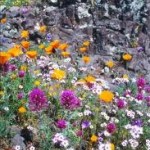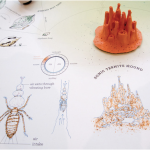botany
Palaeobotanist Jennie Andersson has analysed four soil samples for me, all from floor layers inside buildings at Medieval strongholds that me and my team have excavated in recent years. There's one each from Stensö, Landsjö, Skällvik and Birgittas udde. Results were sadly not very informative.
Comments Jennie:
"Overall the fossil and carbonised botanical material in the samples, as well as the recent unburnt material, is meagre … No carbonised cereals were found. Three of the four samples did however contain rather large amounts of unburnt bones and scales from fish plus jurpa, a blanket term…
On Saturday, May 18, the second international "Fascination of Plants Day" will take place under the umbrella of the European Plant Science Organization (EPSO). Join in to see for yourself how fascinating plant are. Show your support for plant science, which is critical for sustainable food production, biobased medicines, and energy. There are 54 countries participating in the Fascination of Plants Day, with over 650 institutions involved and 950 events planned!
Check out this interactive map that shows all of the participating countries.
Here at the University of California,…
Today we took the children to Table Mountain, a volcanic mesa in northern California.
It is a special place, preserved from development by the dense, rocky texture of the soil- no good for farming. We strolled through carpets of flowers Lasthenia californica (California goldfields). Blemnosperma nanum (yellow carpet), Lupinus nanus, Triteleia ixiodies (pretty face), Castilleja exserta (purple owls clover), Triphysaria eriantha (Jonnytuck or Butter 'n' eggs), Eschscholzia caespitosa, (foothill poppy), popcorn flower and gaze at the box kites flying overhead. The blue, grey and white match the…
Great article from "The Annals of Improbable Research" on "Artificae Plantae: The Taxonomy, Ecology and Ethnobotany of Simulacra." It is about time someone did this research:
A previously unacknowledged plant family of significant economic importance plants has been flourishing around us for many years. The fact that this immense and diverse family has been heretofore ignored by most botanists is astonishing--its members are found worldwide in nearly every society. This family is more than a botanical curiosity. It is a scientific conundrum, as the taxa:
1.lack genetic material,
2.appear…
Thanks to some informative comments on my post about figs and wikipedia my knowledge of botany is slowly improving and my admiration of figs steadily increasing. Many species of figs are pollinated by symbiotic wasps, but there are other fig varieties that develop edible, seedless figs through a process called parthenocarpy. A dominant mutation in the plant allows unfertilized flowers to stay on the tree and develop into yummy figs. While these seedless fruits are delicious, the plants that produce them are sterile, able to reproduce only through human intervention.
Fig trees are…
tags: botany, Majavankaalit, skunk cabbage, Symplocarpus foetidus, Helsinki, Finland, travel, photography, image of the day
Symplocarpus foetidus (Family: Araceae) (Majavankaalit or Skunk Cabbage)
Kaisaniemi Botanic Garden, University of Helsinki, Helsinki, Finland.
Image: GrrlScientist, 15 May 2010 [larger view].
The future potential of synthetic biology is usually discussed in terms of applications in fields like medicine, food science, and the environment. Genetically engineered life forms are being designed to make medicines cheaply, to target tumor cells, to make more nutritious food, or to make agricultural plants that are easier to grow with less of an environmental impact, to clean up pollution or produce sustainable biofuels. What if synthetic biology systems were instead designed for use in culture or entertainment?
David Benqué, a student in the Design Interactions program at the Royal…
tags: new species, biology, botany, orchid, tiniest orchid, Orchidaceae, Platystele, Lou Jost
A close-up of the world's smallest orchid, at just over 2mm from petal tip to petal tip.
Image: Lou Jost.
The world's smallest orchid was discovered recently in a mountainous nature reserve in Ecuador by American botanist Lou Jost. Dr. Jost, a former physicist, now works as a mathematical ecologist, plant biogeographer and conservation scientist, and is one of the world's most expert orchid hunters. In the previous decade, Dr. Jost discovered 60 new species of orchids and 10 other new plant…
The Smithsonian Institution has made available on Flickr an amazing set of photographs of early women scientists and engineers.The pictures include women who worked at the Smithsonian and images from the Science Service Archives now housed at the Smithsonian. Some of these women scientists are well-known, even Nobel laureates, while others worked in obscurity. Some used their scientific training and passion to do research, some to save lives as doctors and nurses, some to write about science, some to break the sound barrier, and some to advance the cause of women. To me, all of them were…
A while back I tossed up some of Callie Shell's photos of Obama, and the post turned out to be one of the more popular here at Neuron Culture. Recently Soulcatcher Studios, the site that is running an expanded version of that slide show, has a portfolio of the lovely, strange, and arresting 1928 master work of photographer Karl Blossfeldt: Urformen der Kunst, or "Art Forms in Nature."
Karl Blossfeldt (1865-1932) was a German instructor of sculpture who used his remarkable photographs of plant studies to educate his students about design elements in nature. Self-taught in…
Welcome 4 March readers of The Daily Grail - please be sure to also click on the original post about the DMT article by my colleague, Laura Mariani.
Thanks to Dave Munger & Co's ResearchBlogging.org, I just found a fabulous neuroscience grad student blogger from Emory University: Laura E Mariani at Neurotypical?
Doctor-to-be Mariani blogged last Monday about a paper in Science where the endogenous ligand of the orphan sigma-1 receptor was identified as the hallucinogen, N,N'-dimethyltryptamine, or DMT. The work originated with the group of Arnold Ruoho and colleagues at the University…
Many thanks for some blog publicity go out to Karl Leif Bates, editor of Duke University's online research monthly magazine, Duke Research, and co-founder of Science Communicators of North Carolina (SCONC). Many of you who attended this past weekend's ScienceOnline'09 gathering may recognize Karl as he was in attendance.
Completely independent of any coaxing (Karl was *not* present at my free, Friday Fermentable wine tasting), my post is currently the February 2009 feature on the Duke Research section, Voices: Science in Conversation.
The backstory is that, during our December vacation, we…
tags: sensitive plant, botany, pet plants, streaming video
An interesting video of the Sensitive plant, Mimosa pudica. The music is the intro to 'Baba O'Riley' by The Who. [1:13]
The photographer writes;
I've been growing this unusual plant for a couple of months. The Sensitive plant is a creeping annual or perennial herb often grown for its curiosity value: the compound leaves fold inward and droop when touched, re-opening within minutes. Mimosa pudica is native to Brazil, but is now a pantropical weed. Other names given to this curious plant are TickleMe Plant, Humble plant, Shame plant,…
A few years ago, GlaxoSmithKline marketed Remifemin brand of black cohosh extract from their consumer products division as a hormone-free alternative in managing menopausal symptoms. But after reports surfaced that black cohosh might be associated with cases of liver damage, GSK very quietly walked away. (To date, no one has ever shown that black cohosh is causally associated with liver damage). A company called Enzymatic Therapy continues to sell this product in the US, one that is manufactured by Schaper & Bruemmer in Germany.
Well, here's what happens when GSK gets involved in…
Such was the tagline of a review of Amy Stewart's new book, "Flower Confidential," as written by George Anders in last weekend's Wall Street Journal.
Ms. Stewart, however, is a danger-seeker. In "Flower Confidential" she tests her love by grabbing her reporter's notebook and her passport and traveling to Latin American farms and Dutch markets to explore the commercial flower business.
The result is a quirky but entertaining book. Each chapter becomes a test of wills. Can our happy narrator keep her faith as she learns the ugly truths of an industry with $40 billion a year in global sales? Or…
President Ford and his family have a special place in the heart of Coloradans, in part for helping to popularize the Vail Valley ski resorts - the "Western White House," as it was then known.
Little-appreciated outside Colorado is that the Fords continued to contribute to the Vail and Beaver Creek areas long after the president left office. The Rocky Mountain News reports Mr Ford visited his Beaver Creek home as recently as this past July but had to call the trip short due to the 8100 ft altitude and his health difficulties.
For me, the greatest legacy of the Fords in Colorado is the Betty…
As we discussed briefly on Tuesday, trial results published in the Annals of Internal Medicine revealed that alternative botanical supplements containing black cohosh were without benefit relative to placebo in treating the vasomotor symptoms (e.g., hot flashes, night sweats) of peri- and postmenopausal women.
The Cheerful Oncologist followed up with a post entitled, "Oh M'Gosh! Black Cohosh Squashed and That's No Bosh!, where Doc Hildreth cited another 2006 study from Mayo Clinic investigators demonstrating lack of efficacy of black cohosh extracts against hot flashes. (He noted later that…
If you've been working in this field for any period of time, cocktail party discussions or talks with students invariably turn to nature's greatest trove of biologically-active compounds, those that act on the central nervous system (CNS) as stimulants, euphorics, and hallucinogens.
So, over the last couple of days, I've been enjoying the posts by my relatively new compatriot here at ScienceBlogs, SciBling for short, The Molecule of the Day. I have no clue as to who he/she is or where they are other than it is written, "by a chemist who enjoys rambling about the relationship between…
Most of last week's posts were about music, so I thought I'd round out the holy trinity of sex, drugs, and rock 'n' roll.
Traveling this weekend gave me an opportunity to indulge in one of my secret guilty pleasures: reading USA TODAY.
First up, as it were, is Kitty Bean Yancey's story on the opportunity for Atlanta-based passengers to join the mile-high club in a private plane for just $299:
Q: Who goes on these flights?
A: Couples from 18 and 19 up to their 60s. I've taken between 75 and 100 in five years. I've had people fly in from New York, New Jersey and Miami just to do the mile-high…
Monday's contest to win $50 decoding the chemical and historical nature of the Terra Sigillata banner masthead got such a response that I didn't even expect it. Amazingly, one entrant answered 4 of the 5 questions correctly, with the 5th being closest of anyone.
I'll be contacting the lucky feller forthwith regarding delivery of his fifty American dollars. The answers will follow in subsequent posts, but here are the questions once again of you care to exercise your mind:
1. What is the complete name of the dude on the righthand side of the banner and why do you think I picked him to as the…





